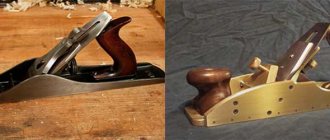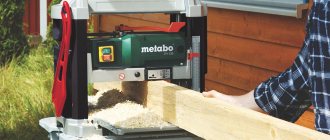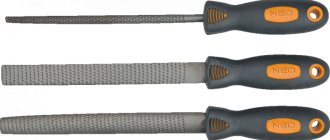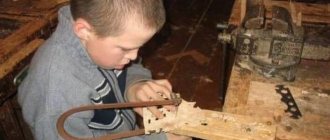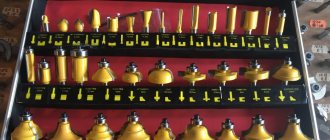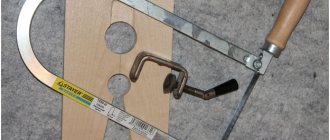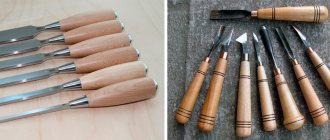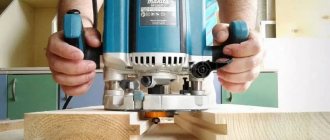What is a wood jigsaw?
The jigsaw appeared during the development of applied carving from thin plates of precious woods, which later became known as intarsia. Bow saws were already known to mankind, and by analogy with them, a jigsaw was created - a file stretched into a wooden frame. Jigsaw files are wood saws, but their dimensions were quickly reduced and the number of teeth increased.
A hand jigsaw is a very popular device. Despite the existing disadvantages, which are associated with a low level of productivity, as well as the inability to solve a large number of tasks assigned to it, for example, sawing thick wood, precise cutting and adjusting edges, straight cuts, this tool is still very popular today. Probably the main reason for its popularity is its low cost. Today, you can buy a good manual jigsaw for about 2-3 dollars, and a professional tool for 6-7 dollars.
The design of all manual jigsaws is similar. The main components are:
- wooden handle
- saw clamp
- metal case
- file
Several photos of a jigsaw for wood are presented below.
There are two main types of blades, which differ in their shape and arrangement of teeth:
- blade with straight double teeth. With this blade you can make a straight cut in a short time. Its length reaches 130 mm, while the working length is approximately 85 mm. Excellent for sawing both wood and plastic
- spiral. Features a twisted shape and is ideal for creating a variety of circles and sinuous lines.
How to choose a jigsaw and files for it
Given the variety of models on the market, choosing the right option can be not so easy. In order not to make a mistake when choosing, you need to at least in general terms imagine the structure of a jigsaw.
The main components of a modern jigsaw
To understand the principle of operation, consider the structure of a regular household jigsaw.
Of course, depending on the manufacturer, the device of different models may differ, but in general the device remains the same:
- cutting regulator - modern models are equipped with it without fail. This is logical, because you can cut not only wood, but also plastic, aluminum and even steel. Instructions for cutting different materials require a different speed setting for each of them;
The device of a modern jigsaw
- multi-stage pendulum mechanism - it is used to ensure that the canvas oscillates not only in the vertical, but also in the horizontal plane. Thanks to this, the material is cut when the saw moves only in one direction; during the reverse stroke, the blade moves slightly back, thereby extending its life;
Pendulum mode can be disabled
- As a rule, in modern devices, files are not attached using screws or wings, but a special system is used to facilitate this process. Simply press the lever, remove the old one and insert the new blade;
- It will also be useful to be able to rotate the canvas around its axis by 360ᵒ. This is useful if you need to cut a round hole or any other closed contour. Instead of twisting your hand, you just need to turn the blade itself. Cutting out various patterns from wood with a jigsaw with a rotating blade is a pleasure;
- Sometimes it becomes necessary to make a cut at an angle. So the ability to fix the angle of inclination will also not be superfluous; the angle lock allows you to rigidly fix the angle in the range of 0-45ᵒ;
Angle lock allows you to make cuts at an angle
- the engine is cooled by a small fan, part of the air flow is directed directly to the cutting line, so that sawdust does not clog the markings and the line to be followed is always visible;
- The addition of a laser can significantly improve cutting accuracy. The laser beam is directed at the material being processed and when working, you just need to combine it with the markings; this is convenient if the view is partially blocked.
Laser beam improves the cutting accuracy of the workpiece
As for choosing a specific model, the main criterion can be considered cost. The fact is that household jigsaws can quite cope with lumber with a thickness of about 50-70 mm, as well as steel sheets up to 2-4 mm thick.
In most cases, this is more than a solution to all problems that arise during home renovation or construction, but such jigsaws cost 3 times less than professional models. The disadvantages include a shorter service life and a simpler design.
The number of blade vibrations per minute is also important. Most often, this indicator is in the range of up to 3000 vibrations/min; there are also more productive models, but their cost also increases.
Selection of files and operating rules
Jigsaw blades differ in many ways, including the material from which they are made, the type of fastening, the quality of the cut, etc. It can be difficult for a non-specialist to choose the appropriate option for their needs, so let’s look at the main types of files and their area of use.
Depending on the material being processed, the following files can be distinguished:
- for metal;
- wood;
- metal and wood;
- any other materials (in addition to plastic and foam plastic, steel, aluminum, tiles, etc. can also be cut).
Comparison of the design of a file for wood and metal (A and B) and a universal blade (C)
The design of the teeth greatly affects the quality of the cut:
- files for high-speed cutting have set, ground teeth. Due to this, the cutting speed is maximum;
- if the teeth are not set apart, the speed will decrease somewhat, but the edges of the cut will be without chips and perfectly smooth;
- Jigsaw blades for wood with wavy milled teeth are suitable only when the quality of the cut does not matter.
The shape of the tooth is of great importance. The fact is that blades with straight teeth are sawed in a top-to-bottom motion, but with reverse teeth, it’s the other way around. Therefore, when working with saws with reverse teeth, you need to fix the part, otherwise it may rise when the blade moves from bottom to top.
You also need to pay attention to the shape of the fastening; options with fastening in the form of the letter T or U are possible.
Types of shanks
In order to be guaranteed not to get confused, you just need to understand the markings of the canvases. Most questions will disappear on their own.
You need to pay attention to:
- color marker on the shank (white indicates that the blade is suitable for wood and metal, gray for wood, red for plastic, blue for metal, black for other materials);
- letter designation T or U, characterizing the method of fastening the canvas;
- the following number indicates the length of the blade (1 – no more than 75 mm, 2 – from 75 to 90 mm, 3 – from 90 to 150 mm, 7 – over 150 mm);
- the letters ABCD can be used to indicate tooth size;
- other letters are used to show the purpose of the file. F means that the file is bimetallic, O – intended for curved cutting, R – with a reverse tooth, P – blade of increased thickness (for cutting at an angle), X – the file is considered universal, HM – a high-strength alloy is used.
Examples of markings of some files
For example, the marking T101BIF means that a T-shaped fastening is used, the length of the blade is up to 75 mm, the tooth is small, the blade is bimetallic. Such a canvas can be used to very cleanly cut laminated chipboard and other capricious materials with your own hands.
How to make the right choice?
To make the right choice and purchase a manual jigsaw for wood, you need to take a close look at a few things. First, pay attention to the shape of the tool. For example, a rectangular jigsaw is suitable for some purposes, while a pointed jigsaw is suitable for others.
The weight of the tool is also important. Working with a hand jigsaw is a long and tiring task; your hand gets tired quickly. For this reason, it is worth choosing light and comfortable manual jigsaws that have anatomical handles (shaped like a hand). It is noteworthy that lightweight devices are produced by foreign companies, while Russian companies focus on quality, which means they have a significant weight.
Jigsaws have different frames. It can be made of aluminum, iron, steel and titanium. If you need a durable tool, then you should not buy devices with an aluminum frame, because the strength of aluminum is quite low. The steel or titanium option is, of course, more expensive, but you will get a high-strength product, and the saw blade will not “jump” during the cutting process.
Pay attention to the jigsaw clamps as well. They are different:
- drums
- nuts
Drums will be preferable because they guarantee more comfortable work with the instrument. You don't have to take a set of wrenches with you to change the blade. You will only need to unscrew the drum and replace the blade yourself, without using other tools.
The manufacturing company also plays an important role. You should not buy Chinese hand jigsaws - they do not inspire confidence, and their service life is very short. Among the world-famous manufacturers, it is worth highlighting Stanley and Intertool, as well as Mastertool and Topex. Such companies produce not only jigsaws, but also a line of other construction and carpentry tools.
A hand jigsaw is ideal for working with thin boards, as well as for creating small wooden crafts. However, such a device is not suitable for sawing workpieces whose thickness reaches 40-50 mm.
Types of hand tools
The tool consists of 3 elements: handle, frame and file. When choosing a jigsaw, the material of the frame and handle, the weight of the product, the quality of fastening of the elements, the type of blade and design features are taken into account.
On wood
For comfortable woodworking, you need to pay attention to the following:
- You need to choose the right frame shape that matches the task at hand. For example, a rectangular or pointed tool shape may be used.
- A jigsaw for wood should be light in weight. When painstakingly sawing, a lightweight tool will reduce stress and hand fatigue. You should choose instruments with an anatomical handle. Such models are more often found in the assortment of foreign manufacturers.
- The strength of the frame plays an important role. It is recommended to give preference to titanium or steel jigsaws. The aluminum sheet does not have high strength and will change position upon contact with the material.
Comfortable use depends on the design of the clamps. When choosing between nuts and drums, it is better to give preference to the latter option. In this case, you will not need to use wrenches to change the blade, because These clamps are easy to unscrew.
For metal
The hand tool can handle metal elements up to 1 cm thick. The cutting speed is lower than when working with wood. You should choose a tool with a blade made of high-strength material. Metal files are made of hardened high-carbon steel. Working with small teeth is most effective.
Jewelry
When making decorative cuts, a jewelry jigsaw is used, which will allow you to make small lines and bends. It differs from standard models in its lightness and small size. In this embodiment, the frame is sliding and has a clamp connection. This design provides strong tension on the canvas.
In jewelry work and decorative wood carving with a jigsaw, thin files are used, which often break. Due to the design features of the tool, a longer piece is inserted into the tool to continue working.
For additional thread tension, some models have the frame positioned in the opposite direction from the handle.
Working with a jigsaw on wood
The technology for performing work with a manual jigsaw is not complicated, but the preparatory work is quite important, and the quality of the final product depends on it. First of all, we fix the blade in the jigsaw. To do this, you need to unscrew the clamps located at the bottom and top. You need to insert a file with teeth facing downwards from the jigsaw into these clamps and tighten the clamps.
A special table, loosely fastened with a clamp on top of the desktop, is suitable as a support. They need to be secured in such a way that the groove and hole of the table protrude above the working area. The part to be cut must be placed over the hole, and the saw must be inserted into the hole itself. At the very end of the work, the resulting object must be treated with sandpaper.
Craftsmen distinguish three main types of work with a jigsaw:
- cut along a curve. You need to take the jigsaw in one hand and place the file on the edge of the marking. You need to move the jigsaw up and down. At the very beginning of work, you need to put a little pressure on the tool, but do not overdo it, otherwise you can break it. When working, you need to control the markings and turn the device in the right directions
- cutting the cutout. If you need to make a cutout inside the workpiece, you need to drill a hole with a cross-section of 0.6 mm, insert the blade into it and secure it with clamps. After this, work is carried out in the usual way
- creating straight lines.
How does a wood jigsaw work? The video is presented below.
Recommendations for working with a hand jigsaw
Masters who have long been engaged in wood carving using a hand jigsaw recommend:
- First of all, firmly secure the workpiece with a vice so that it is absolutely motionless
- When cutting, you should try not to put pressure on the workpiece. If you press too hard, the file will break and the sheet material will burst and will not be suitable for a second attempt. At the same time, too soft pressure will cause poor quality of the final product. For this reason, you need to try to increase the pressure evenly from one edge to the other, all the time turning the part so that the cutting occurs smoothly
- decide on one direction for the file. If you have just started working with this tool, then you should not turn the file, because there is a possibility of damage to the part and the file itself. When your hand gets a little more comfortable, you can turn the handle a little. However, make sure that the rotation angle does not exceed 15 degrees
- When cutting a workpiece lengthwise and crosswise, you need to stand up and work with smooth movements from top to bottom. When cutting horizontally, distortions occur in the part.
- with such a shape of the workpiece, when the file often rests against the edge of the part and gets stuck there, it is worth turning the pin vice located on the side and reducing the pressure on the file
- When creating a cutout of a specific shape inside the workpiece, in order not to damage the edges, you need to use an electric drill to drill a hole at the intended point so that a file can be inserted there. After this, the file must be removed from the tool and inserted into the hole, then fasten the jigsaw again. After this you can safely create a cutout
- To avoid the file jumping out of the clamps, you need to periodically fix it by turning the handle. However, don't overdo it or it will break. If, when tensioning, you feel that the nail file is firmly fixed and the handle is difficult to rotate, then you have done everything right
- when simply sawing wood in a straight line, you need to select the maximum saw tension on the tool handle. But for planing the workpiece, choose a lower tension
- When creating complex drawings, you need to draw a sketch on the blank in order to avoid mistakes and create the most beautiful object.
